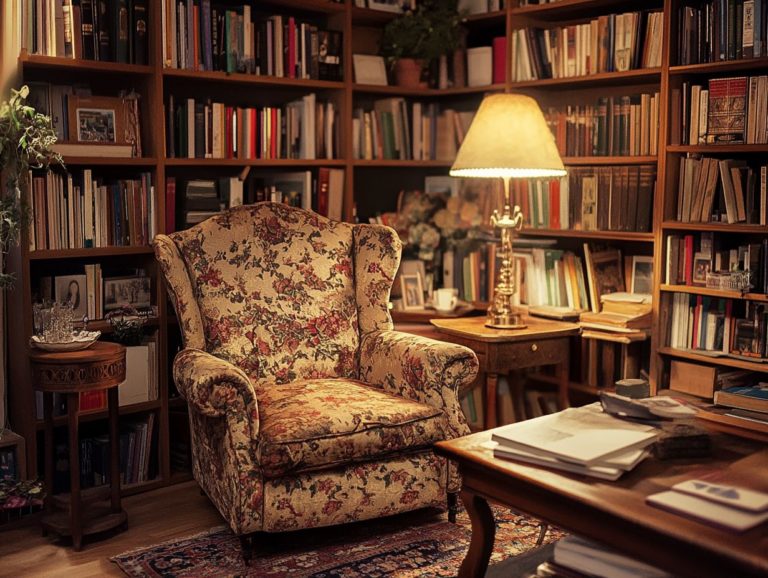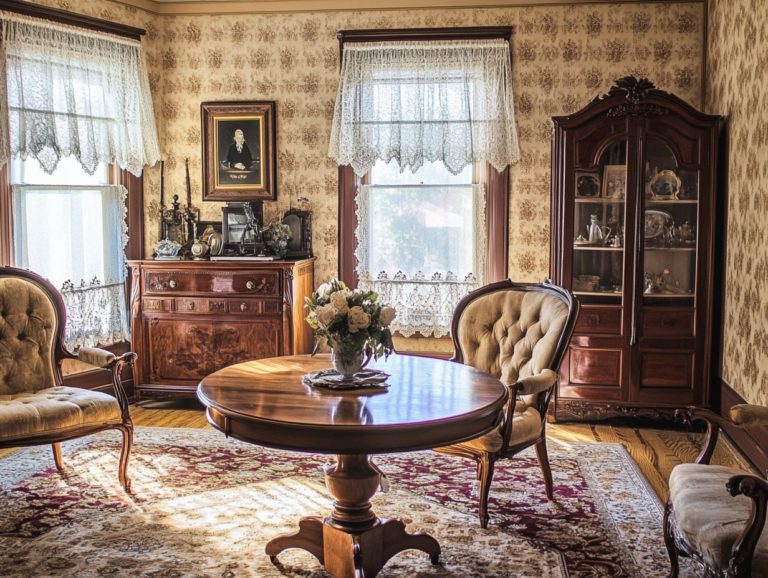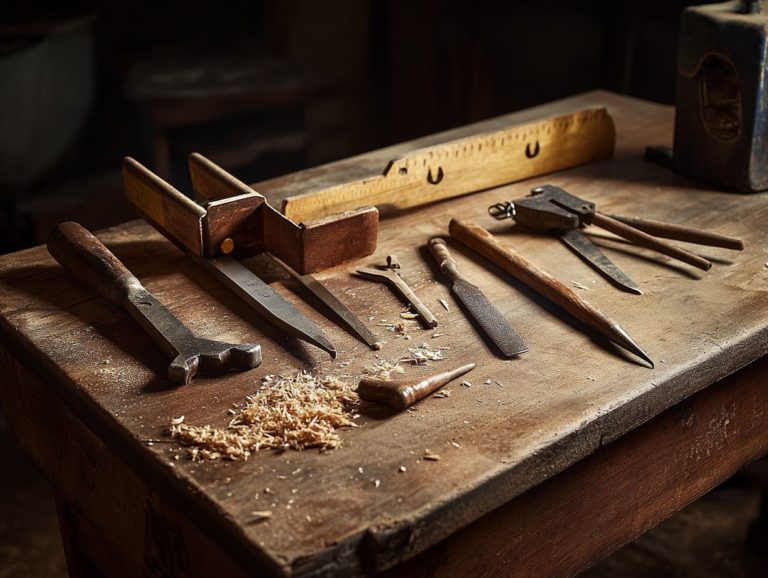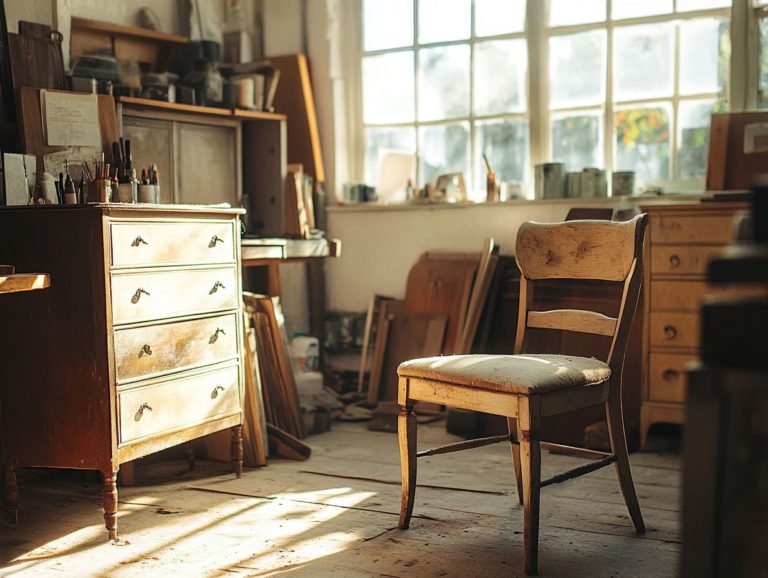Uncovering the Secrets of Vintage Furniture Frame Styles
Vintage furniture frames possess a distinctive charm and character that can truly elevate any space you curate.
This article delves into what makes a frame vintage. You ll learn how to identify and date these pieces! Spot signs of wear and uncover restoration techniques that can breathe new life into them.
You will discover imaginative ways to seamlessly integrate vintage frames into your modern decor, creating a stunning juxtaposition of old and new. Embark on this journey through time and style, and elevate your space with the allure of vintage elegance.
Contents
- Key Takeaways:
- Popular Vintage Furniture Frame Styles
- Identifying and Dating Vintage Frames
- Restoring and Refinishing Vintage Frames
- Incorporating Vintage Frames into Modern Decor
- Frequently Asked Questions
- What is considered vintage furniture?
- How can I identify the frame style of vintage furniture?
- What are some popular vintage furniture frame styles?
- What is unique about Victorian frame styles?
- What are some key features of Mid-Century Modern frame styles?
- How can I incorporate vintage furniture frame styles into my home decor?
Key Takeaways:

- Vintage frames are defined by their age and design, including popular styles like Art Deco and Mid-Century Modern.
- Look for clues in materials and construction to identify and date vintage frames.
- Restoration requires care, but it adds charm to any space.
What Makes a Frame “Vintage”?
Understanding what makes a frame ‘vintage’ is essential. This is true for both collectors and design enthusiasts.
A vintage frame typically boasts a unique design, a certain age, and specific materials that reflect the skill and artistry of its time. These frames, whether made from wood, metal, or other materials, not only carry artistic value but also encapsulate a piece of history, showcasing the craftsmanship of vintage furniture.
The timeless appeal and character they introduce to your home decor truly elevate them to standout elements in interior design. This adds a unique charm that sets vintage-style furniture apart from contemporary pieces.
Victorian frames, with their intricate detailing, stand in striking contrast to industrial designs, which celebrate raw materials and functionality. Furthermore, Scandinavian and Danish Modern pieces exemplify the perfect balance in design, seamlessly merging vintage aesthetics with contemporary usability. If you’re interested in learning more, check out what you should know about vintage furniture styles.
Popular Vintage Furniture Frame Styles
When you delve into the world of popular vintage furniture frame styles, you’ll uncover a rich tapestry of design influences. Each era contributes its unique aesthetic to home decor. From the opulent curves of Art Deco to the sleek lines of mid-century furniture, grasping these styles enables you to fully appreciate the character and charm that vintage frames bring to a space.
Art Deco
Art Deco is a distinctive design style that emerged in the early 20th century. It is marked by bold geometric patterns, vibrant colors, and luxurious materials. If you have a penchant for vintage furniture, this iconic movement will inspire you.
It seamlessly blends modernist styles with fine craftsmanship, showcasing an array of unique pieces adorned with vintage hardware and intricate detailing.
Originating in the aftermath of World War I, Art Deco encapsulates a period of optimism and innovation. It draws inspiration from ancient cultures and the emerging technologies of the time. The rich colors deep blues, golds, and greens create an opulent ambiance that evokes the glamour of sophisticated interiors.
This aesthetic continues to influence modern furniture design. Designers today frequently reference iconic Art Deco elements, ensuring that its timeless essence remains relevant. This celebration of elegance and sophistication keeps the spirit of this extraordinary era alive, inviting you to embrace its allure in your own space.
Mid-Century Modern
Mid-Century Modern is a captivating design movement from the 1940s to the 1960s. It’s characterized by sleek lines, organic shapes, and a focus on functional elegance. This style has become a cornerstone of vintage furniture collections!
Notice its emphasis on simplicity and harmony with nature. Iconic pieces like the Eames Lounge Chair and the Noguchi Coffee Table highlight the exquisite balance defining this era.
These remarkable pieces do more than enhance your living spaces; they embody a philosophy that beautifully intertwines art and utility. The movement champions craftsmanship while celebrating minimalism and form. Thoughtful use of materials wood, metal, and plastics demonstrates an innovative spirit that broke free from traditional design constraints.
By blending comfort with style, this design ethos has set the stage for contemporary trends. The allure of Mid-Century Modern continues to resonate with enthusiasts and collectors today!
Victorian
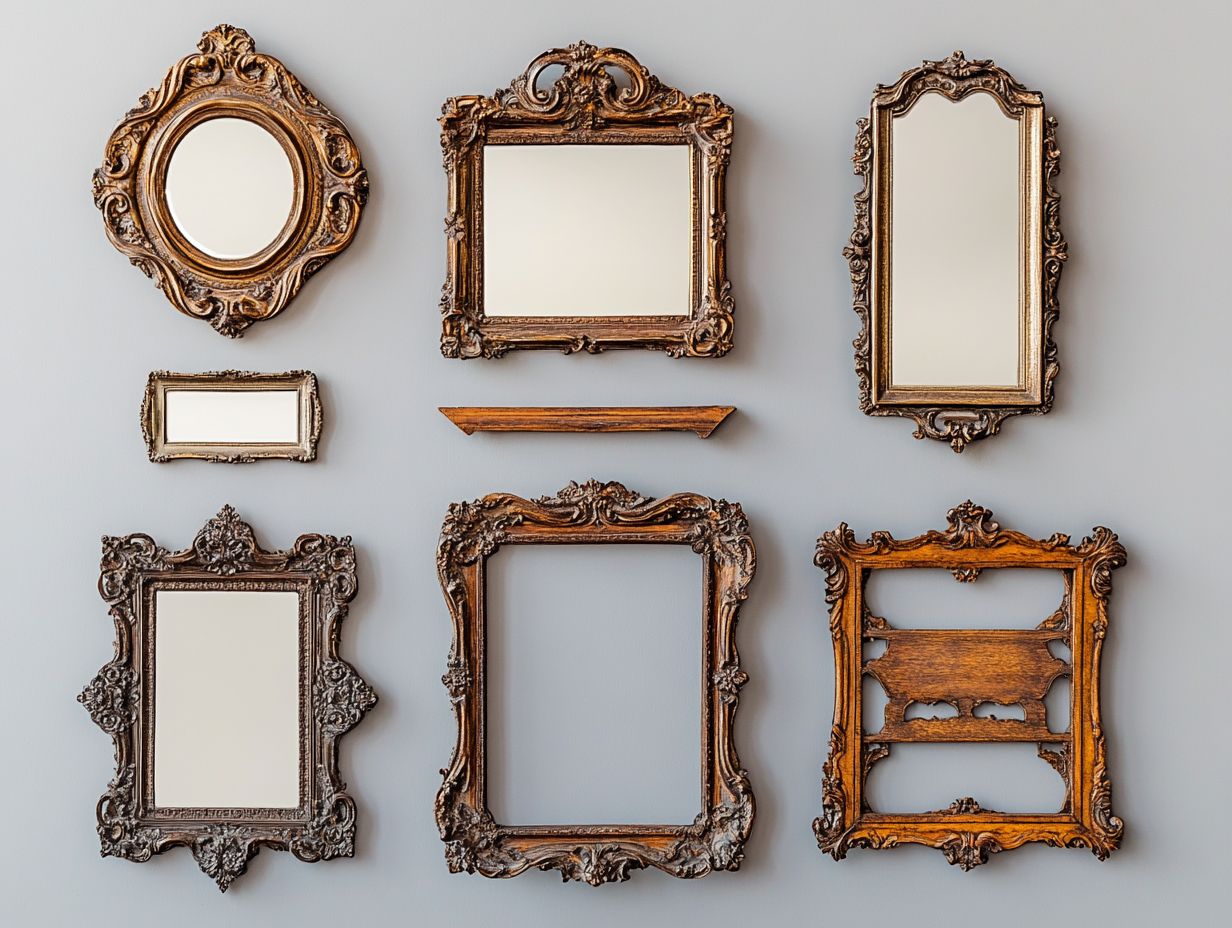
Victorian furniture showcases elaborate designs and ornate detailing, capturing the opulence of its era. This style is cherished by antique furniture collectors and interior designers alike.
Crafted during Queen Victoria’s reign from 1837 to 1901, this furniture embodies the richness of the industrial age. It blends traditional techniques with emerging technologies. Plush sofas, intricately designed sideboards, and elaborate parlor chairs reflect a deep appreciation for beauty and comfort.
The use of dark woods like mahogany and walnut, complemented by sumptuous velvets and brocades, shows meticulous attention to detail and a genuine love for luxury. These pieces not only allure aesthetically but also mirror societal shifts, representing a time when craftsmanship was held in the highest regard.
Industrial
Industrial style furniture has surged in popularity, distinguished by its use of raw materials like metal and reclaimed wood. It features a practical design that merges retro elements with contemporary style!
Common features include exposed pipes, riveted surfaces, and distressed finishes. Each element invokes a sense of history and authenticity. Many appreciate how these vintage-inspired pieces become conversation starters, easily blending into both minimalist and eclectic decor.
Their versatility allows them to harmonize with various color palettes, making them ideal for spaces from chic urban lofts to cozy vintage-inspired nooks.
This fusion of old and new creates a unique, edgy appeal. It invites you to express your individuality while embracing the charm of industrial heritage.
Identifying and Dating Vintage Frames
Identifying and dating vintage frames is an invaluable skill for collectors and enthusiasts. It offers a glimpse into the authenticity and history of these remarkable pieces!
Numerous factors play a role in the identification process: materials used, construction methods, and distinctive signs of wear and tear that indicate a frame’s age. Understanding these elements enhances your collecting skills and provides critical insights for restoration and investment in furniture exemplifying true craftsmanship.
Don’t miss out on exploring how these styles can enhance your space!
Materials and Construction Techniques
The materials and construction techniques found in vintage frames are key to establishing their authenticity and value. This highlights the exceptional craftsmanship that defines these timeless furniture pieces. You ll often encounter classic materials like solid wood, metal, and glass, artfully combined with traditional construction methods. This attention to quality sets vintage frames apart from their modern counterparts.
Solid hardwoods, such as oak, walnut, and cherry, are particularly valued for their durability and lasting beauty. They ensure these pieces remain resilient over the years. Techniques like dovetail joints a strong way to connect two pieces of wood hand-carving, and mortise-and-tenon construction not only enhance structural stability but also showcase artistry that is increasingly rare today.
The patinas and finishes applied to vintage frames enhance their unique character, telling stories of craftsmanship that span generations. This invites both buyers and admirers to appreciate the lasting charm of these exquisitely crafted items.
Signs of Wear and Tear
Signs of wear and tear in vintage frames can reveal their age and authenticity. These indicators are crucial for collectors and design enthusiasts to consider. Signs can range from minor scratches and a lovely patina to more noticeable damages that may require restoration techniques to maintain the integrity of the antique furniture.
Identifying these signs deepens your appreciation for vintage craftsmanship and helps you make informed decisions when investing in furniture.
As you examine the nuances of each imperfection, you’ll gain valuable insights into the frame’s history and usage over the years. A worn finish or loose joints can indicate the need for careful restoration, preserving not just the frame s beauty but also its fascinating story.
As a collector, it’s important to remember that some faded areas can be rejuvenated with the right techniques. This ensures that the underlying craftsmanship and materials remain intact. Understanding these elements helps you preserve the functional aspects of the furniture while honoring the artistry behind these treasured pieces.
Restoring and Refinishing Vintage Frames

Restoring and refinishing vintage frames is an exquisite art that requires a clear knowledge of materials, techniques, and the historical significance of each piece. For those who appreciate craftsmanship, this task can be incredibly rewarding.
By employing proper restoration techniques, you can revitalize these frames, preserving their distinctive character while ensuring they serve as functional and stylish decor elements in modern spaces. Whether you’re using vintage hardware or modern refinishing methods, your aim should be to maintain the integrity of the frame while enhancing its timeless allure. For more on this topic, check out understanding vintage furniture styles by era.
Best Practices and Tips
When it comes to restoring vintage frames, following best practices and using effective restoration tips can truly elevate the final product. This allows these unique pieces to shine beautifully in any home decor. It’s essential to know the right materials, tools, and techniques to maintain the frame’s original charm while making necessary repairs that respect the craftsmanship behind these vintage treasures.
Selecting suitable finishes, adhesives, and fabrications that match historical styles is crucial. Prioritizing conservation over alteration is vital; preserving the patina and texture is what gives the frame its character.
Using gentle cleaning methods will help prevent damage, while techniques like re-gluing joints and replacing broken glass restore functionality without compromising authenticity.
Every decision you make during the restoration process should reflect a deep appreciation for the artistry and history of vintage frames. This ensures they remain both functional and beautiful for future generations to admire.
Incorporating Vintage Frames into Modern Decor
Incorporating vintage frames into your modern decor presents a remarkable opportunity to merge the old with the new, crafting a harmonious balance that elevates your interior aesthetics.
You can mix and match styles, seamlessly integrating vintage-inspired details into contemporary settings. This transformation turns ordinary spaces into eclectic showcases that narrate a compelling story.
Whether you use vintage frames as striking focal points on a gallery wall or as charming accents on sleek modern furniture, they enhance your overall design with their unique character and timeless allure.
Mixing and Matching Styles
Mixing and matching styles in interior design opens the door to creative expression that enhances the visual appeal of any space, especially when you incorporate vintage frames alongside modern decor.
This method highlights great balance in design. Vintage frames add contrast, breathing life into contemporary pieces and creating a dynamic and eclectic atmosphere that is both stylish and inviting.
To achieve this harmonious blend, start by selecting frames with unique textures and colors, placing them against a crisp white wall to draw the eye. Imagine a collection of ornate, aged frames displayed above a sleek, minimalist sofa; this forms a captivating focal point that sparks conversation.
Integrating modern art or prints within these frames enriches the aesthetic, creating a seamless connection between the old and the new. Layering soft textiles and modern furnishings helps maintain a cohesive vibe, illustrating how thoughtfully curated elements can transform a room into a vibrant reflection of your personal style.
DIY Ideas and Inspiration
Transforming vintage frames into stylish decor elements can be an enjoyable and fulfilling DIY project for you. This allows you to infuse your personal touch into your home accessories.
Whether you repurpose old frames into mirrors, create unique wall art displays, or showcase vintage upholstery, you have endless options for creative projects.
By exploring various techniques and materials, you can elevate these projects further, leading to stunning results that add charm and character to any space. Using chalk paint can lend your frames a chic, contemporary vibe, while decoupage allows you to incorporate patterned papers for a whimsical touch.
Adding wire mesh within the frames enhances their utility and provides an ideal backdrop for displaying photos or dried flowers. Upcycling isn’t just about salvaging old items; it’s about crafting pieces that tell a story and highlight your personal aesthetic preferences in home decoration.
Frequently Asked Questions

What is considered vintage furniture?
Vintage furniture refers to pieces that are at least 20 years old but not more than 100 years old. Anything older than 100 years is considered antique.
How can I identify the frame style of vintage furniture?
You can identify the frame style of vintage furniture by examining the construction and design elements, such as the type of wood used, joinery techniques, and decorative details.
What are some popular vintage furniture frame styles?
Popular vintage furniture frame styles include Victorian, Arts and Crafts, Art Deco, Mid-Century Modern, and Hollywood Regency.
What is unique about Victorian frame styles?
Victorian frame styles are characterized by intricate carvings, ornate details, and a mix of different materials, such as wood, metal, and fabric.
What are some key features of Mid-Century Modern frame styles?
Mid-Century Modern frame styles are known for clean lines, simple shapes, and the use of natural materials like wood and leather.
How can I incorporate vintage furniture frame styles into my home decor?
You can incorporate vintage furniture frame styles into your home by mixing them with modern pieces, using them as statement pieces, or integrating them into a specific design theme, such as shabby chic or bohemian.

